Submitted by: Dayle Boyce
January, 2011
“Globe Electric of Milwaukee” is Dale Boyce’s article on this pioneering Milwaukee radio company. Figure 1 below shows the first Globe radios, from about 1922, a model 610 one tube regenerative tuner-detector and a companion model 615 two tube audio amplifier.
Over the years I have had many conversations with people about the radio scene in Wisconsin in the early 1920’s. I have found lots of radio parts made by Allen Bradley, Briggs & Stratton Co., Cutler Hammer, Central Radio Laboratory, Milwaukee Resistor, Lemke and others. I have found radios made with these parts. According to my research including newspapers and other publications, there were at least 30 radio manufacturers in Wisconsin in the 1920’s. Their radios were sold through a variety of stores including furniture stores, department stores, music stores and automotive sales/service stations. There were companies who made radio cabinets, horn and cone speakers, earphones, antennas and other accessories. We will probably never know who all of the individuals were who designed and made these radios. Bit by bit we will share some of the information that we gather in our quest for these collectables. I hope that this article will provide some information to fill in some of the gaps. The people who knew many of the answers are gone.
Globe Electric of Milwaukee
According to www.jci.com, ”… Globe Electric Company was started in 1911 in Milwaukee, WI. Also, according to a 1985 Johnson Controls publication “Right for the Times 100th Anniversary”, Globe Electric was formed in 1911 by G. W. Youngs, D. Decker, and J H. Gugler. The purpose of Globe Electric was to make electrical equipment for street lights, street cars, rural light plants and switchboards. Later, they also made automotive batteries…” The address on literature is 14-28 Keefe Avenue, Milwaukee, Wisconsin. At some point in the early 1920’s they began to make an extensive line of battery radios. Based on visits to radio museums and conversations with collectors, Globe Electric radios can be found all over the world. They were heavily into the battery and wind power business long before rural America was electrified. Battery radios were a product that fit well into their product line.
The 1985 Johnson Controls publication “Right for the Times 100th Anniversary” notes “In 1925, Globe stopped making radio sets, and with the acquisition of Central Radio Laboratories, turned to the manufacture of radio components”.
Globe Electric Co made a lot of different things including radios as indicated in the following list of Globe publications from the back cover of Radio Bulletin 21:
Bulletin A: Globe Light and Power Direct Connected Engine Plants
Bulletin B: Globe Belted Lighting Plants
Bulletin 3: Globe Motor Generator Charging Sets
Bulletin 4: Globe Types A and B Series Charging Switchboards
Bulletin 8: Globe Faure’ Type Storage Batteries
Bulletin 9: Globe Series Parallel Switchboards
Bulletin 10: Globe 110 Volt Auto Battery Charging Panels
Bulletin 11: Globe 32 Volt Garage Type Auto Battery Charging Panels
Bulletin 13: Globe 32 Volt Home Type Auto Battery Charging Panels
Bulletin 14: Globe 32 Volt Utility Motors
Bulletin 15: Globe 40 Volt 20 Ampere Type G8 Generators
Bulletin 16: Globe 32 Volt Junior Switchboards
Bulletin 17: Globe 32 Volt Enclosed T.C Contactors
Bulletin 18: Globe Faure’ Battery Repair Parts
Bulletin 21: Globe Radio Equipment and Accessories
Bulletin 22: Globe Auto Batteries, Parts and Accessories
Bulletin 23: Cars; Plans; Terminals for Globe Auto Batteries
Other Globe publications in the Boyce Collection include:
Radio Bulletin 25: (Undated)
Radio Bulletin Number 28: (undated).
Bulletin 28A Price List: (February 9, 1925)
Radio Bulletin No.28B: Globe DuoDyne Receivers, Parts, Accessories (undated)
Bulletin 28C: (undated)
Bulletin 28C Price List: (February 1926)
Bulletin 30: Radio Batteries and “A” Power Units (10-1-26)
Bulletin 30-A: Storage Batteries for Radio Service (undated)
Bulletin 30-B: Storage Batteries & Power Units for Radio Service (September 5, 1928).
The Radio Bulletins include complete radios as well as all of the components necessary to build radios from scratch. They also sold batteries, antennas, earphones, speakers, tubes, testers and radio related materials. Some of the Model numbers were assigned to different products which can add a measure of confusion.
With the electrification of cities across the land, the demand for battery radios diminished. In 1929 Globe Electric merged with Union Battery and became Globe-Union Inc. Their primary product line was automotive batteries. In 1978 Globe-Union was acquired by Johnson Controls. Johnson Controls continues to be a major researcher, manufacturer and supplier of automotive and specialty batteries.
Discovering Globe Radios
From the early 1980’s until it closed in 2000, I remember seeing Wisconsin manufactured radios at the Muchow Museum in Elgin, Illinois. I attended the Antique Radio Club of Illinois (ARCI) Radiofest event many times and always looked forward to the tours of the museum. I remember seeing radios and speakers made by Western Coil, Oriole (W-K Electric), Hansen Storage Co., Klitzen, Borchert & Manegold, Yahr-Lange, Granolite and Globe Electric. Globe Models included 770, 810, 830, 880, S4, 626 and possibly others. I have several photos from those visits. The Model 526 in the Boyce Collection was purchased at the 2001 Muchow Auction).
I saw a Globe 605 on page 12 in the Photo Review section of the December 1987 issue of ARC.
When I attended the AWA event at Rochester New York in 1989 I saw a Globe 810 in the back of a vehicle. The owner indicated that it would be in the general auction. I was surprised when it was not in the auction. I tracked down the owner and he indicated that someone had made him an offer he could not refuse.
In 1991 I saw an advertisement in ARC indicating that a Globe 610 and 615 were for sale. I called the same day that I received the ARC but they had already been sold. The seller said that he had college tuition to pay for one of his children. The seller offered to and did send a few photos of the radios.
For some reason, Globe radios seemed to disappear rapidly when they did become available. For some reason, although these radios are listed in the McMahon, Johnson and Fathauer/Grinder books, they generally do not appear in the Bunis/Schlusser Antique Radio Guide Books and price guides.
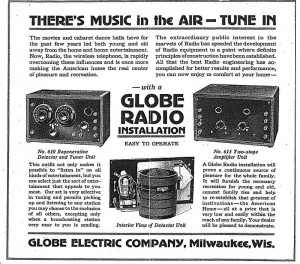 Figure 2 – Globe 610 and 615, Globe Brochure
Figure 2 – Globe 610 and 615, Globe Brochure
The first Globe radios appear to be a Model 610 one tube regenerative detector and a Model 615 two-tube amplifier, see figure 1 on page 1. These are also shown in an undated brochure, see figure 2 on page 7.
The cabinets for the 610 and 615 have a recessed hinged cover and rounded corners. They could be purchased together with accessories as Model 600. The No. 600 Globe Radio Outfit complete with all accessories sold for $132. The No. 670 Globe Loud Talker speaker was an additional $25. Both cabinets are the same size, with dimensions of: 11.25“ wide x 7“ tall x 7.5” front to back.
Monroe H. McKillup of Chicago offered a Model D-7 detector and Model A-7 amplifier. They are priced at $35 each in the 1923 Andrae Catalog R-5. These look very similar to the 610 and 615. See figure 3. This photo was taken at the home of Dick Bury. These radios previously belonged to Carl Knipfel. This Globe 610, Globe 615 and Monroe D-7 are in the Boyce Collection.
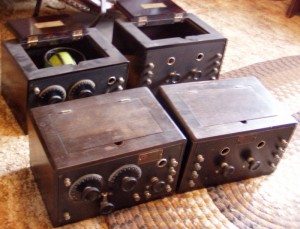 Figure 3 – Globe 610 and 615 (front), Monroe D-7 and A-7 (rear).
Figure 3 – Globe 610 and 615 (front), Monroe D-7 and A-7 (rear).
See figure 4 for a close-up of the label on the D-7 – note the reference to the regenerative license held by Tri-City Electric Supply Co., of Davenport , Iowa.
One of the interesting similarities about these sets is the use of the same components. There is speculation that they appear to have been manufactured in the same facility. For instance, many of them utilize the BASCO (Briggs & Stratton Co. of Milwaukee, WI) tube sockets, captive binding posts and other BASCO parts. The cabinets are similar. The layout of component is similar. See figure 5. (BASCO Radio will be a future Wisconsin radio story).
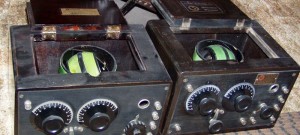 Figure 5 – Monroe D-7 (left), Globe 610 (right)
Figure 5 – Monroe D-7 (left), Globe 610 (right)
The 1923 Montgomery Ward Company Radio Wireless Telephone, Wireless Telegraph Equipment Catalog offered similar radios named the Airline Special (detector) and Airline Two-Stage Audio Frequency Amplifier. The detector set only sold for $28.50. The detector with accessories sold for $49.50. The amplifier sold for $21.00. The Airline DeLuxe included the detector, amplifier and accessories. The Airline DeLuxe sold for $89.00. The Airline radios are pictured in the catalog with full top covers. This is consistent with examples that are known to exist.
The Globe Model 605 was a single cabinet with 3 tubes. The 605 was essentially the 610 and 615 combined into one cabinet. See figure 6.
The Monroe Model DA-7 looks like the Globe Model 605. The DA-7 is priced at $75 in the 1923 Andrae R-5 Catalog. See figure 7 below, taken from Milwaukee based Julius Andrae & Sons 1923 Radio Catalog R-5.
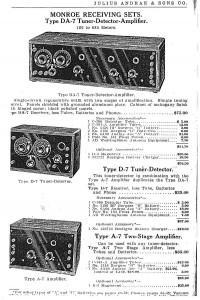 Figure 7- Monroe D-A-7, D-7, A-7
Figure 7- Monroe D-A-7, D-7, A-7
Globe Radios: Model 611 / 616
Globe Model 611 Detector and 616 Amplifier followed and are described in Globe Bulletin 21. They were similar to the 610 and 615 but with a simpler cabinet with a full hinged overlapping top like the Airline Detector and Amplifier. They were priced at $25 each. The 611 / 616 combination was also offered as Model 600 for $100. This should not be confused with the earlier 610 / 615 Model 600. (Suggestion: get some clarification if a Globe Model 600 comes up in conversation).
According to Bulletin 21, the Model 607 was the combination of the 611 and 616 in a single cabinet. The basic radio was priced at $55. The Model 601 with tubes, headphones and accessories was $105. The cabinet is 16.75“wide x 10“tall x 6“front to back. At least 2 different versions of the 607 are known. Both are different than the image in Bulletin 21. See figures 8 and figure 9. These two sets were on display at the March 2010 WARCI swap meet in Milwaukee, WI.
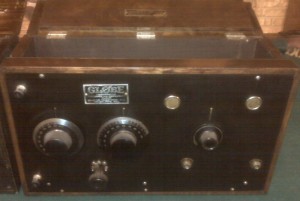 Figure 8 – Globe 607, One Configuration
Figure 8 – Globe 607, One Configuration
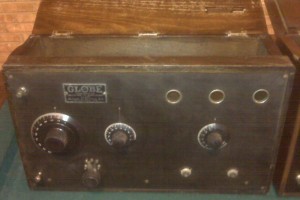 Figure 9 – Globe 607, a Second Configuration
Figure 9 – Globe 607, a Second Configuration
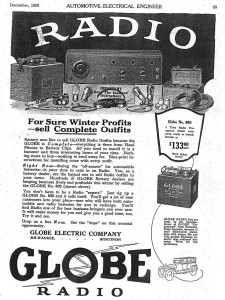 Figure 10 – Globe Advertisement
Figure 10 – Globe Advertisement
Globe Radios: Models 805 and 810
An advertisement on page 33 of the December 1923 issue of Automotive Electrical Engineer (see figure 10) shows a 4-tube Globe Model 805 complete with accessories. It sold for $133 without speaker.
The Globe Model 810 appears on the cover of Bulletin 21 (see figures 11 and 12). It is housed in a tall cabinet similar to the 607. The 810 was also offered as Model 800, 801 or 802 depending on the accessories that were packaged with the radio. The basic 810 was $80. Model 800 was $140. Model 801 was $173. Model 802 was $ 160.
Other “800” series radios included the Model 815 with meter, model 820 and model 830. The 900 series followed. The 900 also has a meter in the face of the cabinet.
Globe Radios: Other Models
Other models included variations of the 770. It is frequently seen with either the engraved nameplate or with a metal applied nameplate. Figure 13 shows both variations.
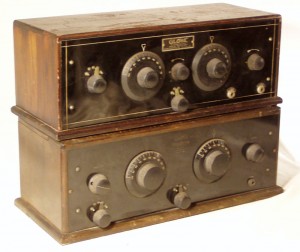 Figure 13 – Globe 770 Variations
Figure 13 – Globe 770 Variations
Other later models included the 252, 253, 353, 526, and 626. See figure 14 for a photo of a model 353 and figure 15 for a photo showing a model 626 over a model 526.
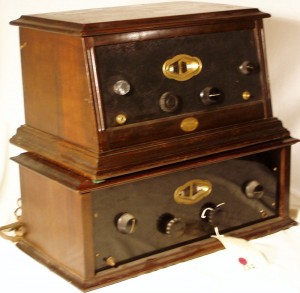 Figure 15 – Globe 626 above a Globe 526
Figure 15 – Globe 626 above a Globe 526
Many of the later Globe radios were engraved with the brand name Duodyne as well as a model number.
Globe also made radio chasses for installation into furniture such as sideboard cabinets and phonographs. One was included in the Dr. Ralph Muchow Auction in 2001. Another is a 5-tube model 1160. See figure 16.
Identification of Globe Radios
Models 605, 610 and 615 usually have a brass nameplate fastened to the front panel. The lettering is raised and the infill is black. These nameplates have the model numbers, some licensing information and the words “Globe Electric Company, Milwaukee, WIS”. They also have a small (3/8 inch diameter) circle with the North and South American continents (globe) encircled with the words “Globe Electric Company”. This outer 9/16 inch diameter circle is infilled with red. Some units also have paper labels in the covers.
The Model 607 examples have a metal nameplate on the front panel in slightly different locations. These have raised “silver colored” letters on a black background. They also feature the large GLOBE name with lightning bolt logo. Both 607 models also had a stamped copper “nameplate” on the inside of the cover. These nameplates indicate that the radio or portions of it were manufactured by the Klitzen Radio Company of Racine, WI. (This dates the radio nameplate to a time prior to April 1925 when Klitzen was listed with a Grand Rapids, Michigan address). (See Alan Douglas Radio Manufacturers of the 1920’s, Volume 2 page 167).
Other models with rectangular “silver colored” metal nameplates include the 770 and 820.
Model 626 has an oval shaped stamped brass nameplate on the front panel.
In Models 353, 526, 770, 815, 830, 900 and 1160 in the Boyce Collection, the “nameplate” information and the “Duodyne” trademark name are engraved into the front panel. These also have the stylized word GLOBE with a lightning bolt forward slashed thru the O.
In Models 770, 815 and an unmarked set (possibly made for Sears Roebuck) in the Boyce Collection the front panel also has a distinctive single line border scribed into the panel approximately ½ inch from all four edges.
Most of the Globe radios have a stamped numbered metal tag fastened to the chassis.
Globe Radio Bulletins: Listing and Dating Globe Radios
Dating the Globe Electric radios is a challenge. Several model numbers were re-used on successive radios. Most of the Globe Bulletins are not dated or maybe I have not researched them deep enough to find out when they were printed. One may speculate that the Bulletins were printed consecutively and therefore the later, undated ones were probably published between 1923 and 1925.
An undated Globe brochure lists the following models: 610, 615, 600 (models 610 and 615). The speculative date is 1922.
Globe Bulletin 21 (undated) lists the following models: four-tube Model 810 (800, 801, 802), 611 Regenerative Tuner-Detector, 616 Two-Stage Amplifier, three tube Model 607 (601), Model 600 (611 and 616), No 625 (Globe) Loud Talker ornamental horn for $22.00. This same horn appears on pages 18 and 51 of the 1923 Montgomery Ward Co. Radio catalog for $9.75.
An undated Globe brochure lists the following models (complete for earphone reception):770 (771), 815 (819), 900 (901), 775 (776), Globe Console Radios No 772, 773, 825, 826, 902, 903, and Globe Radio Table No. 20 with built-in speaker. In general, the images of the console radios show radio panels without nameplates or engraving. If you find a “Globe” radio chassis without identification, it may have come out a console or it may be a relative.
Globe Radio Bulletin 25 (undated) lists the following models: 775 (776, 777, 778), 815 (816, 817, 818).
Globe Bulletin 28 (undated) lists the following Radio Models 770, (771), Console (38 inches high, 30 inches wide, 13 inches deep) versions No 772 Console with 770, 773 Console with 771. No. 775 (776) 9 inch high, 16 inch wide panel), 815 (819), 900 (901). Consoles (39 inches high 36 inches wide, 127 inches deep) including No. 825, 826, 902 and 903. Shown on page eight is the No 20 Globe Radio Table, and Radio Model Nos. 611, 612, 616 and 617.
Globe Bulletin 28A Pricelist (Feb 1925) lists the following models: a series of Model 770 and variations including 771, 772 and 773 series. Prices ranged from $50 to $184.
Globe Bulletin 28B Globe DuoDyne Receivers Parts Accessories: (undated) includes models 2-53, 3-53, 900, 770, 830, 834 (Console version of 830), 904 (Console version of 900), and the No. 20 Globe Radio Table.
Globe Bulletin 28C (undated) lists the following models: 626 (627, 628), 526 (527, 528), 253 (254, 255), 830 (831, 832), 770 (771, 772).
The Globe Bulletin 28C pricelist (Feb 1926) lists the following models: 626 (627, 628), 526 (527, 528), 253 (254, 255), 830 (831, 832), 770 (771,772). Prices without tubes were 626 $52; 526 $35.75; 253 $45.50; 830 $42.25; 770 $26.
Other Listings of Globe Electric and Globe Radios
The Globe Electric Company was listed in the Radio Merchandising Buyers’ Guide for 1922, the Radio Dealer Yearbooks for 1923-24 and 1925-26, the McGraw-Hill Trade Directory, November 1924 and August 1925, and the McGraw-Hill Trade Catalog / Directory, November 1926.
Globe radios were listed in the Radio Industry Radio Receiving Sets listings in 1924 (June), 1925 (June and November), Radio Retailing’s Receiving Sets listing in 1925, the Radio News Set Directory in 1925, and the Radio Merchandising Specifications listing of 1926.
Globe radios were included in the John F. Rider Complete Trouble Shooter’s Manual, Set Catalog, published in 1933 (which was the basis for the McMahon bluebook noted below).
Vintage Radio 1887-1929 by McMahon/Greenwood indicates the following Globe models and years:
1923: 810.
1924: 770, 775, Duodyne, 815 Duodyne, 900 Duodyne, 815, 900.
1925: Panel, 700, 770, 772, 830, Duodyne Series-775, 815, 880, 900.
1926: Duodyne.
The McMahon “Radio Collector’s Guide 1921-1932” (Bluebook) indicates similar Globe models and years with a few inconsistencies.
WARCI member, Greg Hunolt, has compiled a more complete tabulation of Globe Electric Radios, features, tube counts, circuit types and dates in his “Battery Set Compendium”. It is available to download from the WARCI website, www.warci.org . I encourage you to view it to supplement this article.
Globe Accessories and Related Items
Figure 17 shows the Globe 2400 ohm earphones. These earphones were previously owned by Carl Knipfel and Dick Bury. Globe Bulletin 21 page 12 clearly shows other earphones including the distinctive 2000 ohm and 3000 ohm units made by BASCO.
Bulletin 21 shows a variety of Globe radio “A” and Radio “B” batteries. In addition, the bulletin offered French “Ray-O-Vac” “A” and “B” batteries made in Madison, WI. (Ray-O-Vac will be another WI Radio Story).
On page 33 of Bulletin 21, the 4-pin tube socket is a BASCO tube socket. It is described as follows:
“The tube sockets used in Globe No 605 sets are strongly constructed of heavy brass, oxidized black and riveted on a black Bakelite base. Contact springs are of phosphor bronze.“ They were available for table mounting, panel mounting and completed with grid condenser mounting clips and panel mounting bracket. See figure 18 below.
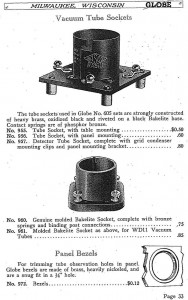 Figure 18 – BASCO Tube Sockets
Figure 18 – BASCO Tube Sockets
BASCO also made grid leak resistors of a unique size for these clips.
The nickeled binding posts shown on page 34 of Bulletin 21 are the “captive” non-removable knurled knob type. They are described as being supplied on Globe Nos. 601, 610 and 615 units.
They also are used on Monroe and Airline radios. They also appear in BASCO literature from 1922.
Bulletin 30-B, September 5, 1928, shows that Globe made battery eliminators including the Model B (see figure 19 below). This one is pictured on page 4. It is described as Catalog No. 400. It uses a QRS 85 milliamp rectifier tube or equivalent. On a side note, I wonder what the reaction was for a company so deep into batteries to get on the band wagon with battery eliminators.
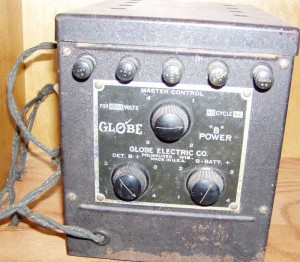 Figure 19 – Globe B Battery Eliminator
Figure 19 – Globe B Battery Eliminator
Globe Radio Advertising
Globe radios were advertised in publications such as The Milwaukee Journal and Sentinel, The Prairie Farmer, Radio Industry and Radio News. In 1924, 1925, 1926 Globe radios were sold through Milwaukee stores including Badger Music Shop, Hartman’s (Department Store), Home Furniture, Waldheims and The C.W. Fischer Furniture Co. A Feb 1, 1925 ad by Hartman’s shows a Globe 815 DuoDyne for $110 and a Globe 770 for $55. A March 1, 1925 ad by C. W. Fischer lists a 4-tube Globe complete with accessories for $110.25 and a 5-tube complete for $157.25. A March 15, 1925 ad by C.W. Fischer lists a 5-tube Globe DuoDyne in a side-by-side phonograph cabinet for $196. A Feb 21, 1926 ad by Hartman’s lists a Globe 815 for $55 and a Globe 900 for $69.
Conclusion
Other known “Globe Radios” were made by Globe Radio Co of Detroit, MI, Globe Phone Mfg. Co. of Reading, PA, Globetrotter, and Globe Electronics of New York. Other radios which appear to be very similar to Globe radios are known. I will leave it to others to tell us about the Globe Electric relatives and their stories.
I express my thanks to the following people for conversations, correspondence, copies of materials and photos which were the basis for this article: Greg Hunolt, Glenn Trischan (copies of price lists), Ralph Larsen, Dave Milke, Stuart Oliver, Joe Grivitz, Jim Collings, Jay Volke, Bob Paquette, Keith Winey, Carl Knipfel, Ken Wirth, Charlie Kempker, Cheryl Dudzik, Steve Raymer, Chris Boyce, Katie O’Brian (Globe model 605 photo), the late Dick Bury, the late Bob Evans, the late Joe Pavek and the late Dr. Ralph Muchow. Special thanks to Ken Wirth and Charlie Kempker at the Johnson Controls Archives. I apologize if there are others who have shared information that I have not listed. Any errors in the article are mine.
Corrections, comments, photos, artifacts and information about 1920’s radios made by Globe Electric and other Wisconsin Companies are always welcome. You can contact me at via email.
More Globe Photos!
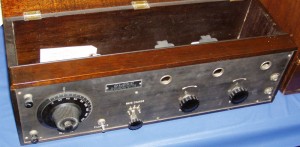 Figure 21 – Globe Model 820 (incorrect knobs)
Figure 21 – Globe Model 820 (incorrect knobs)
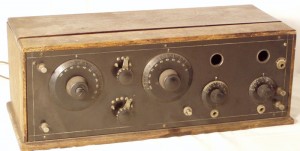 Figure 24 – This set appears to be a receiver made by Globe possibly for sale by Sears.
Figure 24 – This set appears to be a receiver made by Globe possibly for sale by Sears.

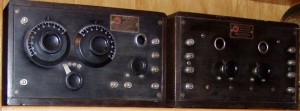
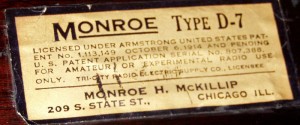

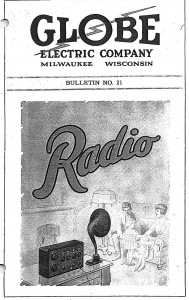
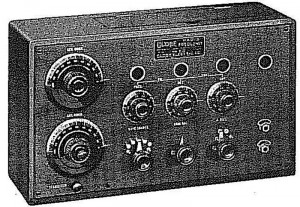
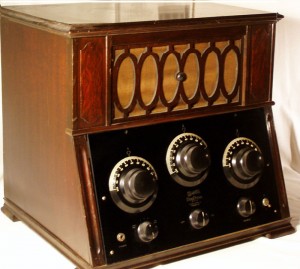
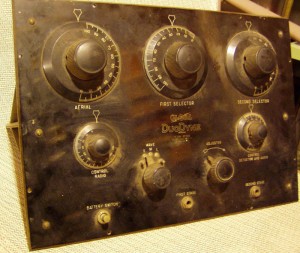
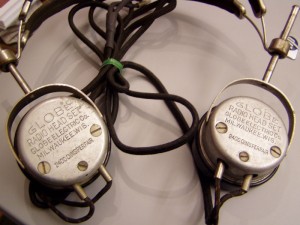
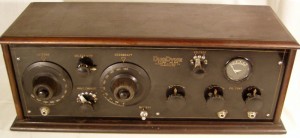
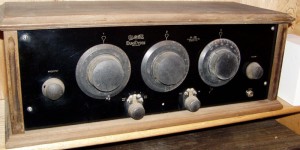
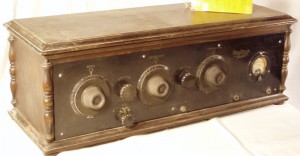
The first Globe sets were likely built by Briggs & Stratton under Tri-City’s Armstrong license. Since we know from the tag that the Monroe D7 was built under Tri-City’s license it is logical to assume the identical Globe 610 was also. Since all of these sets were built with what looks to be entirely Basco components it would be logical to assume they were built during the time frame Tri-City was using Briggs and Stratton to manufacture their sets. It is no wonder that Westinghouse was upset about all of this and filed suit in 1923 to stop it.
Alan Larsen
I have just acquired a Globe 610 detector unit. Could you folks steer me to a schematic for it?
73
Ken Ketner
klaine@mac.com